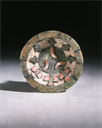Description
This large ear ornament was likely once worn by a high status Moche individual. Decorating the body was an important way for the elite members of Moche society to demonstrate power and wealth. Particularly in public and ritual events, high status Moche people would adorn themselves in sumptuous costumes made of feathers, textiles, and precious metals. Jewelry, including necklaces, bangles, nose ornaments, ear ornaments, and pectorals, was a significant feature of these opulent costumes. Caches of such jewelry have been excavated from elite burials on the north coast of Peru, suggesting that the wealthiest Moche would have had their choice of beautiful objects to wear. Individual pieces of Moche jewelry can be seen in museums and private collections around the world. In addition to these sources, many Moche ceramic depictions show people wearing large nose ornaments, necklaces, and/or ear ornaments.
The ear ornaments that are both seen in artistic representations and found in the archaeological record vary in size and style. The most common form of ear ornament is the ear spool. The majority of these round spools are made out of precious metals and inlaid with semi-precious stone or shell. The large frontal of the piece would have been attached to a thick metal stem that could be inserted into the ear lobe. Both the length and weight of the stem would have counter-balanced the heavy spool and kept it facing outward. Many of the ear spools were decorated with geometric designs, animals, or human figures.
This ear ornament is unique because it is not made out of metal. Instead, the main portion of the object is made out of white shell, possibly formed from the inner spiral of a large Strombus shell. This material is decorated with pieces of green stone, possibly serpentine, and pink shell, possibly Spondylus. The ear ornament is also unique because, while most Moche earpieces are flat, this object is flared. The green stone circle at the center is the deepest part of the ornament, resting about an inch lower than the outer edges. In addition to the green stones edging the piece, the ear ornament is inlaid with five war clubs. The pink shells that decorate the central green circle and also adorn the bottom half of the ornament are probably not original. Not only do they appear to be attached using a modern material, they form shapes that are not seen in Moche art. It is likely that the pink shells were applied in modern times to both fill in missing stones and make the object appear more visually appealing. As the Moche tended toward symmetrical designs, it is likely that this ear ornament was originally decorated with eight war clubs emanating from the central green circle, which probably represents a shield. Therefore, this object would not only serve as a status symbol for the wearer, it would also provide a reference to the popular Moche theme of warfare.
Exhibition History
"Lasting Impressions: Body Art in the Ancient Americas" , Dumbarton Oaks, Washington, DC, 10/1/2011 - 3/4/2012.
